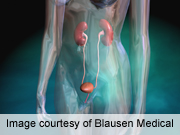
MONDAY, April 9 (HealthDay News) — For women with urinary incontinence, the available treatments may cause more problems than they solve and many stop taking the medications because of side effects that can include dry mouth and constipation, a new analysis indicates.
Urge incontinence is marked by frequent, sudden urges to urinate that can result in leakage and accidents. Standard treatment includes lifestyle changes, pelvic floor exercises, bladder training and/or medication. There are several types of medications that may be used alone or together for the condition. Generally, these medications relax bladder contractions and help improve bladder function.
Researchers from the University of Minnesota School of Public Health analyzed data from 94 studies to see how well the available drugs worked. A given medication was deemed effective if women achieved a 50 percent or more reduction in daily episodes of urge incontinence. Researchers also compared side effects and discontinuation due to side effects of the drugs. Overall, drugs were more effective than a placebo in helping women stay dry, but the improvements were small and treatment discontinuation due to side effects was frequent, the review showed.
There were few head-to-head comparisons in the literature. One study showed that Toviaz (festerodine) bested Detrol (tolterodine) in helping people stay dry. More women stopped taking Ditropan or Urotrol (oxybutynin) due to side effects than Detrol. The lowest rates of treatment discontinuation was seen with 5 milligrams of Vesicare (solifenacin). The review was funded by the Agency for Healthcare Research and Quality.
“Since all drugs for urgency incontinence have comparable effectiveness, therapeutic choice should consider the harms profile, and women should be informed about all possible adverse effects,” the researchers concluded. Their report appears in the April 10 issue of the Annals of Internal Medicine.
Dr. Elizabeth Kavaler, a urologist at Lenox Hill Hospital in New York City, said she always starts with behavioral changes to help women manage urge incontinence. “Kegel exercises, fluid restriction and staying way from bladder irritants such as coffee, tea juices and alcohol are the first-line treatments, and if they don’t improve, we move to medication.”
“Some women find these drugs work great and don’t have any side effects,” she added.
Dr. Yvonne K. P. Koch, an assistant professor of urology at the University of Miami Miller School of Medicine, said the findings run counter to what she sees in her practice. “Some women may not be 100 percent dry, but are 50% improved and are pretty happy with that.” She said she always starts women at the lowest dose of the drug with the fewest side effects.
“There is a lot of trial-and-error,” she said. “Most people do try two or three before they find one that works.”
More information
Learn more about the causes and treatments of urge incontinence at U.S. National Institutes of Health.

